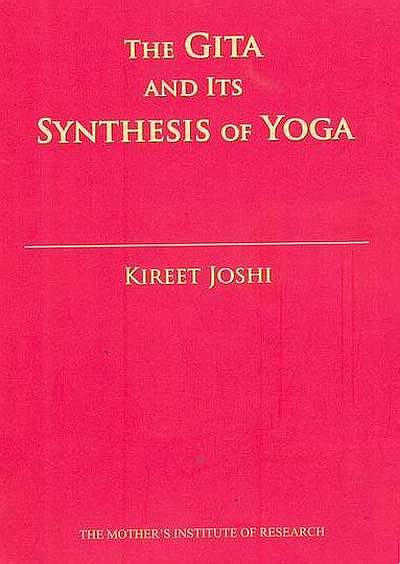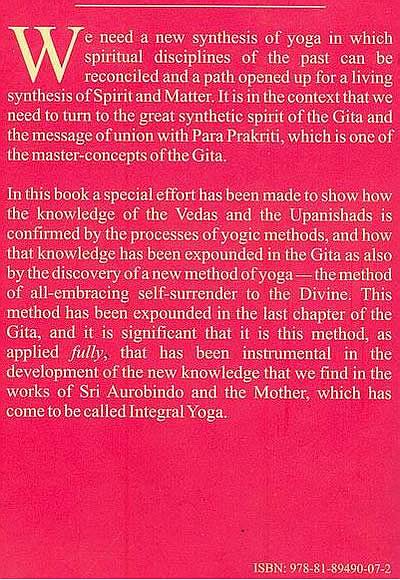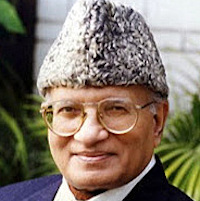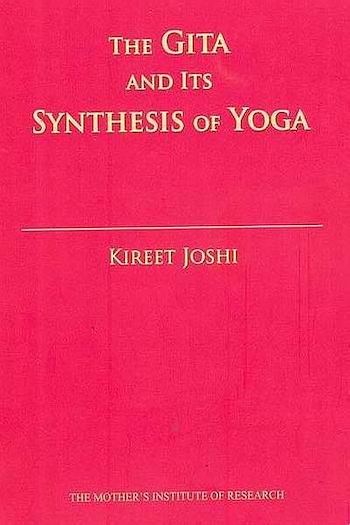The Gita and its Synthesis of Yoga

Notes and References
The age of intuition appears to be too long as compared to the similar age that we find in the history of comparable cultures. This is because the deliverance of intuition that were gained during the Vedic period came to be once again reiterated and retested during the period of the Upanishads, which did not follow immediately after the age of the Vedas; when the Vedic knowledge began to decline, there intervened a period of a good deal of loss of the secret of the Veda, and even during the period of the Brahamanas, those secrets could not be recovered; but the Upanishadic seers developed powers of intuition and they interpreted the Veda, not by intellectual ratiocination but by taking recourse to the yogic methods that had developed during the Vedic period. This implied a period of a great efflorescence of intuitive faculties. This period was again the period of Intuition. It is well-known that in many ancient civilizations, there was the age of mystery such as that of Orphic beliefs and Eleusinian mysteries in ancient Greece. But when that period of mysteries declined, the age of Reason began to develop. There was no parallel movement such as the one that developed in the period of intuition of the Upanishads. To use the terminology of the Greek gods, the reign of Apollo, the God of revelation, was followed by the reign of Athena, the goddess of Reason. The reason why the Indian trend of thought, during the Age of Reason, came to be greatly influenced by knowledge derived from intuition can be traced to the recurrence of the Age of intuition during the period of the Upanishads, even when the Age of Intuition that marked the development of the Vedas had declined. In other words, the Age of Intuition of the Upanishadic times came to determine the overarching characteristic of Indian culture.
Vide., Bhagawad Gita (BG), 1.28-46
Vide., Ibid., II.4-8
Kant's doctrine of the categorical imperative has great similarities with the Indian doctrine of Dharma, the special emphasis of which is on the Gospel of Duty. Kant's doctrine is anti-utilitarian, since it
Page 150
formulates the ethical awareness of the Right, which points to the intrinsic character of right action on no other ground than the rightness of action perceived directly by the intuitive light of that part of the complex human consciousness which falls outside the framework of Pure Reason, within the realm of which one is obliged to view the universe through Space and Time and through four other categories of consciousness of Quantity: unity, plurality, totality; of Quality: reality, negation, limitations; of Relation: substance and accident, cause and effect, reciprocity; and of Modality: possibility, existence, necessity.
In other words, the realm of pure reason does not provide the ground for freedom, which is exhibited in the ethical urge towards normative action. According to Kant, it is in the field of Practical Reason that the genuine freedom is experienced, since it is in that experience that one finds an ultimate unanalysable idea of "ought or duty". Indeed, Kant's doctrine of duty for duty's sake has been subjected to major criticisms in the western history of Ethics, but we are not concerned here with those criticisms. As a matter of fact, these criticisms are largely applicable to the three formulations that he gave to the idea of the categorical imperative. The idea that there is something like intrinsic Right, which is irrespective of the consideration of consequences, seems to hold for many an unassailable position. In respect of the Indian concept of Dharma, and in the Gita's exposition of Dharma and of its Gospel of Action, when it is said that one has a right to action and not to the consequences or fruits of action, one feels, at first sight, a close resemblance to Kant's doctrine of duty for duty's sake. But when we analyze the two doctrines, Gita's doctrine and Kant's, we find that there are wide differences. Briefly, it can be said that the Indian concept of dharma is much wider than the idea of duty for duty's sake. The idea of dharma, in the first place, recognizes the value of hedonistic (kama) principle and even utilitarian (artha) principle at a certain level of development of the human being. Secondly, dharma carries with it the flexibility in regard to the standards of action that should be applied to different categories of human beings on account of differences of swabhava, the innate tendency of nature determined by the status of the evolution of the given individual in his upward growth. This flexibility is not to be found in the doctrine of Kant. Thirdly, the idea that dharma should be followed simply because it is dharma is only one side of the argument,
Page 151
but it is not the overarching and ultimate idea of dharma. It is implicit in the Indian idea of dharma that its imperativeness is derivable from a still higher source of imperativeness, namely, the imperativeness that issues from the spiritual element in the individual that seeks or affirms freedom of will but also freedom from will so as to attain a status in which one can experience total liberation from the entire realm of action, even while one may be «engaged in actions of will. Moreover, even when one is engaged in actions of will, the Gita's aim is to liberate these actions, not only from the clutches of desires but also from the clutches of the sense of doership of action or from egoism; this idea is absent from Kant's doctrine, where the sense of individual doership of action and individual's obligation to remain within the confinement of the field of action is indispensable. Fourthly, the doctrine of dharma in the Gita is evolutionary in character, and it makes a distinction between swadharma (one's own law of action) and paradharma (another's law of action), and points out that each individual has dharma appropriate to his swabhava, and therefore one should not emulate somebody else's dharma while performing one's own action. The doctrine of duty for duty's sake carries with it the idea of the applicability of one universal ethical law of action to all; the Gita goes deeper into the psychological differences that obtain among different individuals and counsels each one to discover swadharma, one's own law of development in following the evolutionary status and nature that the individual has attained at the given time. This psychological subtlety is absent from Kant's doctrine. Fifthly, the Gita points out that there is a status of consciousness, where alternative ethical deliverances of dharma are bound to collide with each other, and there is, therefore, the necessity of developing a still higher vision of right action. That higher vision, according to the Gita, cannot be obtained except when the individual consciousness expands into cosmic consciousness and! even into transcendental consciousness. It is for this reason that the Gita's emphasis on the development of that vision is a part of the search for the right action. The Gita affirms that this search is fulfilled only when one discovers the ultimate source of will; that ultimate source, according to the Gita, is the divine consciousness (which is universal and transcendental) from which the divine will flows out spontaneously for the growth and maintenance of the unity of people, lokasangraha. Finally, therefore, the ultimate message of the Gita is to rise to a
Page 152
higher level of consciousness, to the spiritual consciousness where universal knowledge and universal will are identical; the consciousness of the individual should be so liberated from the deliverances of conflicting standards of actions or dharmas that he can become a willing vehicle of the Divine Will. The great message of the Gita is that one should be freed from the clutches of dharmas and should surrender to the Divine Will. It is for this reason that the Gita is not a book of practical ethics but of the discovery of the necessity to transcend the level of ethics and arrive at the luminous perception of the divine will and equally luminous and even devoted submission to the divine will.
5 BG.,II.50
6 Isha Upanishad, 5
7 BG.,III..I
8 Ibid.,IV.33
9 Vide., Ibid., II.61, III.30, IV.10
10 Ibid.,VII.2
11 Ibid., XV. 17
12 Ibid.,XV.16
13 Ibid.,VII.5
14 Ibid., XVIII.65, 66
15 Vide., Ibid., II.16,II.30
16 Ibid.,IV9
17 Rig Veda (RV), I.164.20
18 Mundaka Upanishad, III.1.1-3
19 Svetasvatara Upanishad, IV.6, 7
20 Ibid.,IV.5
21 Ibid., IV.10
22 Mundaka Upanishad, 1.2
23 Katha Upanishad, I.3.3-13
24 BG.,II.62-3
25 Ibid., II.61
26 Ibid., II. 55-72
Page 153
27 Ibid., II.42, 43
28 Ibid.,II.47
29 Ibid., II.48, 50
30 Ibid.,III.6
31 Ibid.,II.47
32 Ibid., XV.16-18
33 Ibid., VII.4, 5, 7
34 Ibid.,VIII.23
35 Ibid., IX. 4-8, 10, 12-16, 24, 26, 27
36 RV.,X.l29.2
37 Ibid.I.170.1
38 Ibid
39 Ibid., IV.58.3
40 Ibid.X.90
41 Isha Upanishad, 5
42 Katha Upanishad, II.3.8
43 Mundaka Upanishad, II.1.2
44 Kena Upanishad, III. 12
45 5G.XV.7
46 Ibid.,IX.8
47 Vide., Sri Aurobindo, The Life Divine, SABCL, 1971. Vol. 18, pp. 146-7, where we find a statement describing the supermind, which is, in the language of the Gita, Para Prakriti, and where the divine consciousness, which is in the language of the Gita, Purushottama, is stated to be standing back in the idea from the movement which it contains, occupying and inhabiting its works, seeming to distribute itself in its forms. Sri Aurobindo states, "This concentration supporting the soul-form would be the individual Divine or Jivatman as distinguished from the universal Divine or one all-constituting self." This statement is important, because in the Gita itself we do not find any philosophical statement explaining or describing as to how multiplicity of individual souls or jivas is put forth without abrogating their oneness in the Brahmic consciousness. What is clear in the Gita is that the individual is the eternal portion of Purushottama or divine
Page 154
consciousness (XV.7) and that it is the Para Prakriti which manifests itself as individual souls or jivas. (VII.5)
48 BG., II.42
49 Ibid., II.52-3
50 Vide., Ibid., VII.4-14
5* Vide., Ibid., VII.5, XV.7
52 Vide., Katha Upanishad, II.1.5, 12,13,II.2.3
53 BG.,VII.5
54 Ibid.,III.33
55 Ibid.,VII.2
56 RV..X.90
57 Ibid., III. 1.9-10
58 Katha Upanishad, II.1.5
59 Ibid., II.1.12-13
60 BG.,III.27
61 Ibid., VII.1-2
62 Ibid.
63 Ibid.,VII.28
64 Ibid.,VII.16
65 Ibid.
66 Ibid.
67 Ibid.,VII.18
68 Ibid.,XV.19
69 Ibid.,IV.9
70 Ibid.,V.25
71 Ibid.,X.7
72 Ibid.,XI.5
73 Ibid.,III.20
74 Ibid.,IV.9-10
75 Ibid., IV.7-8
76 Ibid.,XIV.2
77 Ibid.,III.21
Page 155
78 Ibid.,IV.18
79 Ibid., IV. 19-21
80 Ibid., V.18-19
81 Ibid.,V.21
82 Ibid,V.3
83 Ibid.,V.10
84 Ibid.,V.8-9
85 Ibid.,IV.23
86 Ibid., VII.4-5
87 Ibid.,V.20
88 Ibid., V.21-29
89 Kena Upanishad, II.5
90 Ibid.,IV.4
91 BG..VI.1-2
92 Ibid., VIA
93 Vide., Ibid., VI.5-7
94 Ibid., VI. 15
95 Ibid., VI. 29-30.
96 Ibid., VI.31-2.
97 Ibid.,VI.31
98 Ibid., VI.46-7
99 Ibid.,VL5
100 Ibid.,X.19
101 Ibid.,IX.8
102 Ibid.,IV.6
103 Ibid.,IV7
M Ibid.,IX.8
105 Ibid., X.19-41
106 Ibid.,XI.l-4
107 Ibid., XI. 15-31
108 Ibid., XI.32-4
109 Ibid., XI.36-48
Page 156
110 Ibid., XI.47-9
111 Ibid;,XI-55
112 Ibid.,XII.20
113 Ibid.
114 Ibid.,XII.6
115 Ibid., XIII.18, XIV.19
116 Ibid., XIII.28, XVI. 19
117 Ibid.,XIII.34
118 Ibid.,XIV.2
119 Ibid.,XIV.20
120 Ibid., XIV.20-1
121 Ibid.,XIV.27
122 Ibid.,XV.19
123 Ibid.,XVIII.41
124 Ibid.,XIII.46
125 Ibid., XVIII.47
126 Ibid.,XVIII.56
127 RV., 1.72.9
128 Ibid., 1.20
129 BG,XVIII.54
130 Ibid., XII.8. Vide. also, XVIII.57
131 Ibid., XIV. 19
132 Ibid., XIII.18
133 Ibid.,XII.20
134 Ibid.,XII13
135 Ibid.
136 Ibid., XII.14-9
137 Ibid,XIL20
138 Ibid.,XV.7
139 Ibid.,VII.5
140 Ibid., XV.16-7
141 Ibid, XIV.5-18
Page 157
142 Ibid., XIV.22-6
143 Ibid.,XIV.27
144 Ibid., XVIII.65-6
145 Ibid., XVI. 1-4
146 Ibid.,XVII.3
147 Vide., .RV, 1.1.5
148 5G.,XVIII.48
149 Ibid.,VII.5
150 Ibid.,XV7
151 Ibid., XVIII.42-4
152 Ibid., XVIII.57
153 Ibid., XVIII.66
154 Ibid., XVIII.60
155 Ibid., XVIII.53
156 Ibid., XIV. 19
157 Ibid.,VI.5
158 Ibid., XVIII.53
159 Ibid.,XV7
160 Ibid.,VII.5
161 Ibid., XII.8, XVIII.56-7, 65, 68
162 Ibid., XII.20, XIII.18, XIV.2, 19-21, 26-7
163 Ibid.,IV.9
164 Ibid., XVIII.65-6
Page 158


